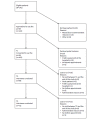Using the Computer-based Health Evaluation System (CHES) to Support Self-management of Symptoms and Functional Health: Evaluation of Hematological Patient Use of a Web-Based Patient Portal
- PMID: 34100765
- PMCID: PMC8262597
- DOI: 10.2196/26022
Using the Computer-based Health Evaluation System (CHES) to Support Self-management of Symptoms and Functional Health: Evaluation of Hematological Patient Use of a Web-Based Patient Portal
Abstract
Background: Patient portals offer the possibility to assess patient-reported outcome measures (PROMs) remotely, and first evidence has demonstrated their potential benefits.
Objective: In this study, we evaluated patient use of a web-based patient portal that provides patient information and allows online completion of PROMs. A particular focus was on patient motivation for (not) using the portal. The portal was developed to supplement routine monitoring at the Department of Internal Medicine V in Innsbruck.
Methods: We included patients with multiple myeloma and chronic lymphocytic leukemia who were already participating in routine monitoring at the hospital for use of the patient portal. Patients were introduced to the portal and asked to complete questionnaires prior to their next hospital visits. We used system access logs and 3 consecutive semistructured interviews to analyze patient use and evaluation of the portal.
Results: Between July 2017 and August 2020, we approached 122 patients for participation in the study, of whom 83.6% (102/122) consented to use the patient portal. Patients were on average 60 (SD 10.4) years old. Of patients providing data at all study time points, 37% (26/71) consistently used the portal prior to their hospital visits. The main reason for not completing PROMs was forgetting to do so in between visits (25/84, 29%). During an average session, patients viewed 5.3 different pages and spent 9.4 minutes logged on to the portal. Feedback from interviews was largely positive with no patients reporting difficulties navigating the survey and 50% of patients valuing the self-management tools provided in the portal. Regarding the portal content, patients were interested in reviewing their own results and reported high satisfaction with the dynamic self-management advice, also reflected in the high number of clicks on those pages.
Conclusions: Patient portals can contribute to patient empowerment by offering sought-after information and self-management advice. In our study, the majority of our patients were open to using the portal. The low number of technical complaints and average time spent in the portal demonstrate the feasibility of our patient portal. While initial interest was high, long-term use was considerably lower and identified as the main area for improvement. In a next step, we will improve several aspects of the patient portal (eg, including a reminder to visit the portal before the next appointment and closer PROM symptom monitoring via an onconurse).
Keywords: chronic lymphocytic leukemia; eHealth; mHealth; monitoring; multiple myeloma; patient portals; patient-reported outcome measures; quality of life.
©Jens Lehmann, Petra Buhl, Johannes M Giesinger, Lisa M Wintner, Monika Sztankay, Lucia Neppl, Wolfgang Willenbacher, Roman Weger, Walpurga Weyrer, Gerhard Rumpold, Bernhard Holzner. Originally published in the Journal of Medical Internet Research (https://www.jmir.org), 08.06.2021.
Conflict of interest statement
Conflicts of Interest: BH and GR have intellectual property rights to the software tool CHES. All remaining authors declare that they have no conflict of interest.
Figures




Similar articles
-
Adherence to Patient-Reported Symptom Monitoring and Subsequent Clinical Interventions for Patients With Multiple Myeloma in Outpatient Care: Longitudinal Observational Study.J Med Internet Res. 2023 Aug 22;25:e46017. doi: 10.2196/46017. J Med Internet Res. 2023. PMID: 37606979 Free PMC article.
-
Patient Portals as Facilitators of Engagement in Patients With Diabetes and Chronic Heart Disease: Scoping Review of Usage and Usability.J Med Internet Res. 2023 Aug 25;25:e38447. doi: 10.2196/38447. J Med Internet Res. 2023. PMID: 37624629 Free PMC article.
-
Disparities in Patient-Reported Interest in Web-Based Patient Portals: Survey at an Urban Academic Safety-Net Hospital.J Med Internet Res. 2019 Mar 26;21(3):e11421. doi: 10.2196/11421. J Med Internet Res. 2019. PMID: 30912747 Free PMC article.
-
Patients' Experiences of Web-Based Access to Electronic Health Records in Finland: Cross-sectional Survey.J Med Internet Res. 2022 Jun 6;24(6):e37438. doi: 10.2196/37438. J Med Internet Res. 2022. PMID: 35666563 Free PMC article.
-
Patient Portals Facilitating Engagement With Inpatient Electronic Medical Records: A Systematic Review.J Med Internet Res. 2019 Apr 11;21(4):e12779. doi: 10.2196/12779. J Med Internet Res. 2019. PMID: 30973347 Free PMC article.
Cited by
-
Usability evaluation of the Computer-Based Health Evaluation System (CHES) eDiary for patients with faecal incontinence: a pilot study.BMC Med Inform Decis Mak. 2022 Mar 28;22(1):81. doi: 10.1186/s12911-022-01818-5. BMC Med Inform Decis Mak. 2022. PMID: 35346170 Free PMC article.
-
Using patient portals for large-scale recruitment of individuals underrepresented in biomedical research: an evaluation of engagement patterns throughout the patient portal recruitment process at a single site within the All of Us Research Program.J Am Med Inform Assoc. 2024 Oct 1;31(10):2328-2336. doi: 10.1093/jamia/ocae135. J Am Med Inform Assoc. 2024. PMID: 38917428 Free PMC article.
-
The impact of curative cancer treatment on sexual health - clinical results from the EORTC QLQ-SH22 validation study.BMC Cancer. 2024 Nov 11;24(1):1374. doi: 10.1186/s12885-024-13123-7. BMC Cancer. 2024. PMID: 39523323 Free PMC article.
-
Adherence to Patient-Reported Symptom Monitoring and Subsequent Clinical Interventions for Patients With Multiple Myeloma in Outpatient Care: Longitudinal Observational Study.J Med Internet Res. 2023 Aug 22;25:e46017. doi: 10.2196/46017. J Med Internet Res. 2023. PMID: 37606979 Free PMC article.
-
Physicians' Perceptions of Clinical Utility of a Digital Health Tool for Electronic Patient-Reported Outcome Monitoring in Real-Life Hematology Practice. Evidence From the GIMEMA-ALLIANCE Platform.Front Oncol. 2022 Mar 17;12:826040. doi: 10.3389/fonc.2022.826040. eCollection 2022. Front Oncol. 2022. PMID: 35372079 Free PMC article.
References
-
- Patient-reported outcome measures: use in medical product development to support labeling claims. US Food and Drug Administration. 2009. Dec, [2020-08-05]. https://www.fda.gov/media/77832/download.
-
- Digital Economy and Society Index (DESI) 2020: use of internet services. European Commission. [2020-09-03]. https://ec.europa.eu/newsroom/dae/document.cfm?doc_id=67075.
MeSH terms
LinkOut - more resources
Full Text Sources

